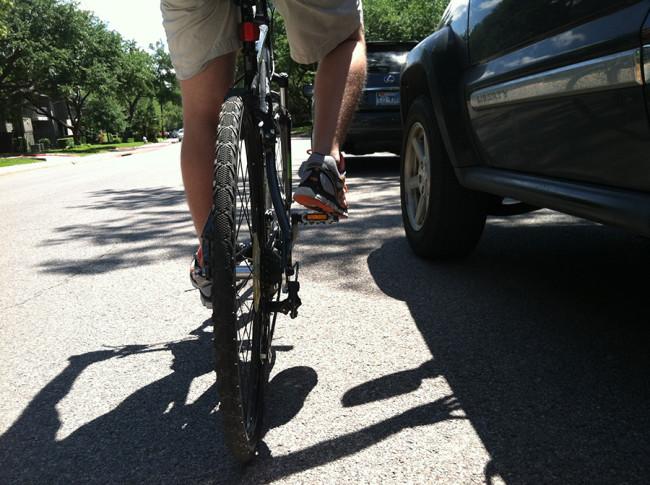
A collapsed lung, a broken left humerus, some broken ribs, two nights in the Baylor University Medical Center, and a four-month recovery period. In late March of 2013, Bruce Levy, an English professor at SMU, was hit by a van while cycling around White Rock Lake.
“This guy just barreled into me,” Levy said. “It was scary.”
By July of that same year, Levy was back on his bike exploring North Texas with the wind blowing through his hair, passing by the blue bonnets sprouting up along the rolling hills.
“I like the wind blowing, the movement, the speed, the terrain,” he said. “It’s a great way to see North Texas and beyond.”
Despite his passion for the sport, Levy is skeptical about whether or not Dallas can truly become a safe and welcoming environment for bikes. Levy says that the driver who hit him wasn’t punished, so he thinks penalties for hitting cyclists need to be more severe and better enforced before people can feel safe riding in the city.
Dallas is in the midst of developing the Dallas Bikeway System, which, as part of the 2011 Dallas Bike Plan, was created in order to “improve the safety, use and efficiency of the bicycle.” Several projects are underway, some expected to open this summer and others in a few years, but many cyclists are not happy with the progress of the plan.
“Dallas is not a bike-friendly city, though they’re trying,” Levy said. “I ‘m lucky I live close to” White Rock Lake. Most of the trails already in place are concentrated in North Dallas, near White Rock Lake, including the 7.6 mile White Rock Creek Trail.
The Dallas City Council is divided over the bike plan, too: some members don’t see the bike plan as that big of a priority. Others are concerned about the cost. The plan is estimated to cost close to $200 million.
So far, there are 18 miles of on-street infrastructure and 125 miles of the trail system completed. When the Dallas Bikeway System is complete, there will be 280 miles of trails, and 840 miles of on-street “facilities”, which are structures like dedicated bike lanes, separated bike lanes, and shared lanes between vehicles and bikes. The total system will be 1,100 miles throughout Dallas County and the edge of Collin County where the two overlap.
Many people living in Dallas see the city as largely designed for car transportation. If there were available alternatives, however, some may gladly switch to commuting by bike.
“We want to give people options. Right now there is no other option but to drive, so streets are so congested,” Jared White, Bicycle Transportation Manager at city hall, said. “Hopefully they’ll take the opportunity the Bikeway System will give them to change that.”
White says that while they have support and approval for the projects, they are not all fully funded yet. Right now, 44 miles of the trail system is either under construction or has funding allocated for construction to begin, much of it along the Trinity River.
Some of the on-street infrastructure projects are still awaiting funding and may require approval by residents, which could delay their construction.
In an attempt to expedite the development of cycling infrastructure, Council Member Philip Kingston, representing District 14 which includes Uptown, lower Greenville, and parts of Deep Ellum, created a citizen bike task force that is targeting the implementation of a bike share program, trail connections, and the acceleration of buffered bike lanes.
Sharrows, lane markings that indicate to drivers where cyclists will operate on streets, like the ones connecting the Santa Fe trail with the Katy trail through Main Street, were the first on-street “facility” put in place. In order to create dedicated bike lines or curbed-off bike lanes, the city staff must request a Thoroughfare Amendment to get permission to change the Dallas Thoroughfare Plan. Until the community is on board, the city cannot start construction on any streets, and depending on the public’s reaction, White said the process could take a few months.
But a lot of cyclists are not convinced that bike lanes are the most effective, or the safest form of bicycle-friendly infrastructure. Scot Montague, an avid cyclist and Facilities Manager of Dedman College at SMU, says that cyclists do not feel safe in lanes off to the side of the road. In order for bike infrastructure to be effective, it needs to be separate from the lanes designated for vehicles, like the bike system in the Netherlands.
Mike Freiberger, board member of Bike DFW, says that in addition to separated lanes being in place for cyclists, people also need to learn how to properly and safely ride bikes in traffic. He says there are plenty of people who want to commute to work by bike, but are hesitant because they do not have the skills necessary to safely do so on Dallas streets, and the infrastructure is not there to reassure them. Bike DFW offers classes for adult cyclists interested in developing skills useful for riding in traffic and commuting to work, such as route planning and crash avoidance techniques.
“When you boil it all down, you have a very car-centric infrastructure that does not encourage people who are interested but tentative to do anything but drive their car,” Freiberger said.
Two parties will be thrown this summer in celebration of the Dallas Bikeway System’s progress, one on Memorial Day, The Uptown Ciclovia, and one on Father’s day, June 17, TheTrinity River Revel. Streets will be shut down from 10:30 a.m.-4 p.m. May 26 for The Uptown Ciclovia event so that people can cycle, run, or walk from the Katy Trail to the Art Distric/Klyde Warren Park Area. The Trinity River Revel will celebrate the opening of the Continental Bridge Park, the Trinity Skyline Trail, The West Dallas Gateway and the Sylvan Avenue Bridge.








